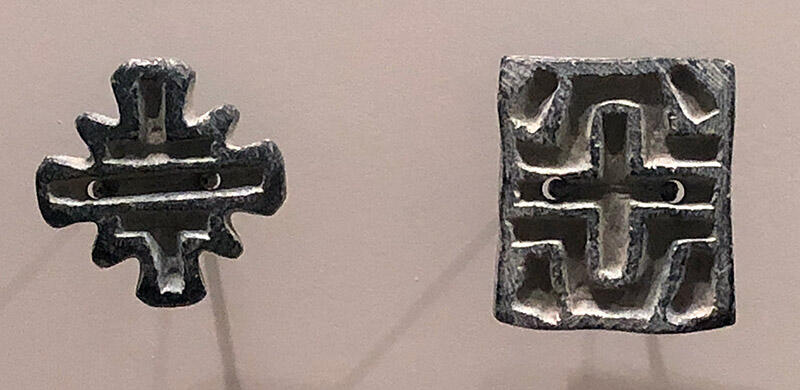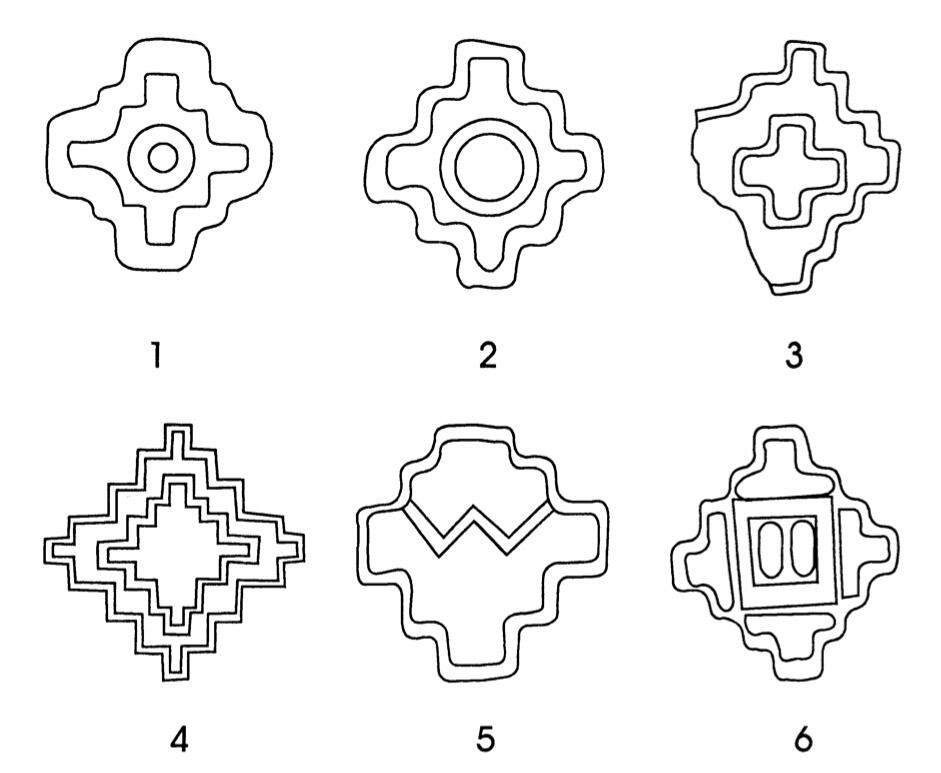Compare the square seal on right with this button seal found at Harappa. These and the stone seals shown earlier are often called "compartmented" seals, with the backs being either open or closed.
Sandro Salvatori in Bactria and Margiana Seals: A New Assessment of Their Chronological Position and a Typological Survey writes: "These and many other elements lead us to conclude that the characteristic production of metal compartment seals that was widespread in the piedmont zone of southern Turkmenistan, Margiana and Bactria, despite the clear-cut regional peculiarities reflected also in other classes of contemporary materials such as the production of terracotta female statuettes (Salvatori 1998b), is only one of the various elements characterizing a cultural koine [common language] that united the above three regions as early as the second half of the 3rd millennium B.C., and perhaps even earlier (although in this case the data are still scanty and fragmentary). It is thus necessary to radically revise the hypothesis expressed in the past by many researchers (e.g. Hiebert & Lamberg-Karlovsky 1992; Sarianidi 1993a, 1998; Jarrige 1994) which situated this phenomenon of cultural affinity between the regions of Bactria and Margiana during the first half of the 2nd millennium B.C. as the virtually unexpected result of environmental crises and population migrations that occurred from time to time from southern Turkmenistan or Bactria or even Baluchistan. We now know that ever since the Chalcolithic, Central Asia, as confirmed by the recent Sarazm excavations in Tadjikistan (Lyonnet 1996), was the theatre of cultural events in the tradition of both southern Turkmenistan and Baluchistan. Consequently any overhasty and simplistic interpretation of a phenomenon so variable in time and space cannot describe events that take on an increasingly complex significance as the research progresses" (p. 136).
Salvatori continues by generalizing about the regional and chronological development of seal types in the larger region: "Returning to the topic of seals and a more general framework it may be concluded that the area of the cylinder seal is strictly limited to the Mesopotamian and Proto-Elamite regions between the end of the 4th and the 3rd millennium B.C. To the East the Proto-Elamite, and to a lesser extent, Sumerian, thrust, although limited to several Northwest Iranic directions, which spreads, and in some cases, imposes the cylinder seal which thus penetrates what would later become the unchallenged area of influence of the compartment stamp seal. Shahr-i Sokhta seems to mark the eastern boundary of this Proto-Elamite penetration: the Period I of the Sistan city is known not only to have yielded a Proto-Elamite tablet but also a substantial number of cylinder seals and clay impressions (Amiet 1979; Amiet & Tosi 1978). Only incidentally and occasionally did this thrust take a more north-easterly direction, as is suggested by the seal published by P. Amiet, coming from Bactria and the specimen from Sarazm in far-off Zarafshan. Southern Turkmenistan, the Iranic North-East, Afghanistan and the Indus Valley are not included in the sphere of direct Proto-Elamite influence. The cessation of the phenomenon outside the consolidated boundaries of the Elamite world in around 2800/2700 B.C. was accompanied, also at Shahr-i Sokhta, as well as in the above-mentioned northern and eastern regions [e.g. Mundigak], by the introduction of the of the compartmented stone seal tradition (but also, albeit to a lesser extent, of the bone and ceramic tradition. Towards the mid 3rd millennium B.C. this was paralleled, in the souhthern Turkmenistan, eatern Iran and Afghanistan regions, by a metal version. in the Indus Valley itself another mainly quadrangular carved stamp seal with quite peculiar stylistic features was to prevail" (pp. 136-137).
Images
1. Note that the crescents in the image are reflections from the glass.
2: Fig. 11-1. Type 5.1 (redr. from Ferioli, Fiandra & Tusa 1979: fig. 1e). Type 5.2 (redr. from Casal 1961: pl. XLV.B.i); 3. Type 5.3 (redr. from Tosi 1983: fig. 74); 4. Type 5.4 (redr. from Tosi 1969: fig. 280); 5. Type 5.5 (redr. from Masson 1981a: pl. XVI. 10); 6. Type 5.6 (redr. from Casal 1961: pl. XLV.B J). From Sandro Salvatori, Bactria and Margiana Seals: A New Assessment of Their Chronological Position and a Typological Survey.




